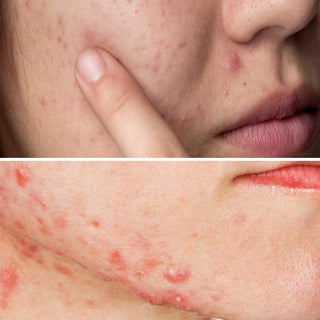Why Your New Skincare Might Be Causing Pimples
Have you ever started an exciting new active ingredient—like a retinol or salicylic acid serum—only to have your skin erupt in pimples a week later? It’s a frustrating experience that makes you want to throw the product away. But before you do, it's crucial to understand what's happening. You might not be having a bad reaction; you might be experiencing skin purging.
While they look similar, purging and a standard breakout are two very different things. Purging is a temporary, positive sign of renewal, while a breakout is a sign of irritation or clogged pores.
This guide will teach you how to tell the difference, how to safely introduce active ingredients to minimize purging, and how to manage your skin through the process.
What is Skin Purging?
Skin purging is a temporary reaction that happens when active skincare ingredients speed up cell turnover. As your skin renews itself, it pushes hidden clogs and dead cells to the surface, which appear as small pimples.
While skin purging can be frustrating, it is actually a sign that your skin is adjusting to the new product. Unlike regular breakouts, which can last for weeks, skin purging is usually short-lived and leads to clearer skin once the process is complete.
Which Ingredients Cause Skin Purging?
- AHA Skin Purge: Alpha hydroxy acids (AHAs) like glycolic acid exfoliate the skin and can cause temporary purging.
- Retinol and Retinoids: Vitamin A derivatives increase skin cell turnover, which can lead to initial breakouts.
- Benzoyl Peroxide & Salicylic Acid: These acne-fighting ingredients can also bring existing clogs to the surface.
How to Safely Introduce Actives & Minimize Purging
You can't always prevent purging entirely, but you can significantly reduce its severity and duration with a smart, careful introduction strategy. The goal is to give your skin time to adapt, not shock it into a reaction.
Strategy 1: Start Low and Slow
Don't jump straight to the highest concentration.
- Start with a lower strength: For example, begin with a 1% Salicylic Acid formula before trying a 2% concentration.
- Start with a lower frequency: Apply the new active just 2-3 times per week for the first few weeks. If your skin responds well, you can gradually increase the frequency to every other day, and then daily.
Strategy 2: Use the "Buffering" Technique
This method is excellent for potent ingredients like retinol, especially for those with dry or sensitive skin. "Buffering" involves applying the active on top of a moisturizer to dilute its intensity.
- The Routine: Cleanse -> Apply a thin layer of a simple moisturizer -> Wait a few minutes -> Apply your active -> (Optional) Apply another layer of moisturizer on top.
- Recommended Product: Our Crème B3-B5-E is perfect for buffering, as its niacinamide and panthenol formula supports the skin barrier.
Strategy 3: Support Your Skin Barrier Relentlessly
A strong, healthy skin barrier is less likely to become irritated. During the purging phase, focus your routine on hydration and repair.
- Use a Gentle Cleanser: Avoid harsh, stripping cleansers. Our Hydrating Gentle Daily Cleanser is formulated to clean effectively without disrupting the barrier.
- Hydrate, Hydrate, Hydrate: Use a lightweight, non-comedogenic moisturizer to keep your skin hydrated and calm. Explore our moisturizers range as they are fungal acne-safe and won't clog pores.
- Wear Sunscreen: Active ingredients can make your skin more sensitive to the sun. Daily use of a broad-spectrum sunscreen is non-negotiable. Explore sunscreens for different skin types.
Is It Purging or a Breakout? 3 Key Differences
| Factor | ✅ Skin Purging (A Good Sign) | ❌ A Bad Reaction / Breakout |
| Location | Appears in your usual breakout spots (e.g., T-zone, chin) where clogs are common. | Appears in new, unusual areas where you rarely get pimples. |
| Duration | Appears after starting a new active and clears up within 4-6 weeks. | Persists beyond 6-8 weeks and may get progressively worse. |
| Appearance | Usually small, uniform whiteheads or pustules that come to a head and heal relatively quickly. | Can include deep, painful cysts or nodules that take a long time to heal. |
The Bottom Line: If your "breakout" lasts longer than a typical skin cycle (about 6 weeks) or appears in completely new areas, it's likely a sign of irritation or that the product is not right for you. In this case, you should stop using it.
Final Thoughts:
Experiencing skin purging can be disheartening, but it's often a necessary step on the path to clearer, smoother skin. By introducing active ingredients slowly, supporting your skin barrier with gentle and hydrating products, and learning to identify the signs of a true purge, you can navigate this phase with confidence.
Patience is key. However, if your skin seems irritated, red, and the breakouts are getting worse beyond the 6-week mark, it's always best to stop the product and consult a professional.

